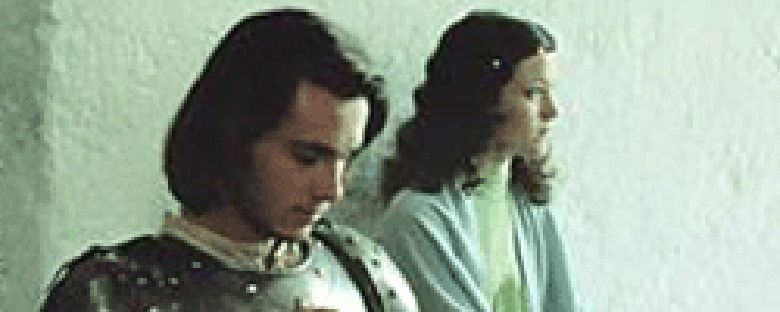Reviews
Lancelot du Lac
Robert Bresson
France, 1974
Credits
Review by Matt Bailey
Posted on 11 July 2004
Source New Yorker Video DVD
Related articles
Features: Directors: Robert Bresson
To fans of the director Robert Bresson, Lancelot du Lac is an action film. To everyone else, the words “Bresson” and “action” in the same sentence is laughable. Bresson is known for stripping away dialogue, movement, characterization, and plot to their barest essentials, sometimes to the point of apparent incomprehensibility. In this film, he applies his rigorous technique to the Arthurian legend, resulting in what is perhaps his most austere (and possibly most opaque and inaccessible) film of all.
The film begins, startlingly, with a seconds-long swordfight — filmed in a close-up so tight as to crop the knights’ bodies almost entirely out of the frame — that results in a decapitation that spews forth geysers of blood. Following this, another knight is stabbed in the crotch, and a third has his head split open inside his helmet (resulting in more geysers). Apart from the bloodbath that sets the grim tone for the film, Bresson is content to suggest action rather than depict it. Two major battles occur off-screen and are represented solely by piles of bloody bodies, and a jousting tournament is symbolized by quick shots of horses’ running legs, lance points, and audience reactions. This extreme purity of style can pose major problems for viewers. For example, those who fail to notice which helmets belong to which characters or which characters wear which color of tights will be unable to determine who has died in the climactic battle at the end of the film. Bresson simplifies style to the point of forcing a viewer to engage in a high degree of work simply to understand the action in the film. Even with a well-known story as its backdrop, it is only upon the third or fourth viewing that one can even begin to contemplate the larger questions at work in the film.
Bresson assumes that the plot should be familiar to most, and it is at least to those who have seen any one of the dozens of film adaptations of the legend of Camelot, from First Knight to Monty Python and the Holy Grail. This film takes as its subject the tail end of the legend, from the return to Camelot from the failed quest for the Grail to the death of Arthur, but it is only interested in the myth insofar as it illustrates the central question of the film: What does God want from us, or more precisely, How do we reconcile the morality that God dictates to us with the morality we feel in our hearts? What complicates the film is that Bresson provides no answer to the question; his goal is merely to raise it and to explore how human beings (even mythical ones) go about attempting to answer the question for themselves. Needless to say, the answer, even if found, provides no happy endings for anyone in the film.
We don’t do comments anymore, but you may contact us here or find us on Twitter or Facebook.



